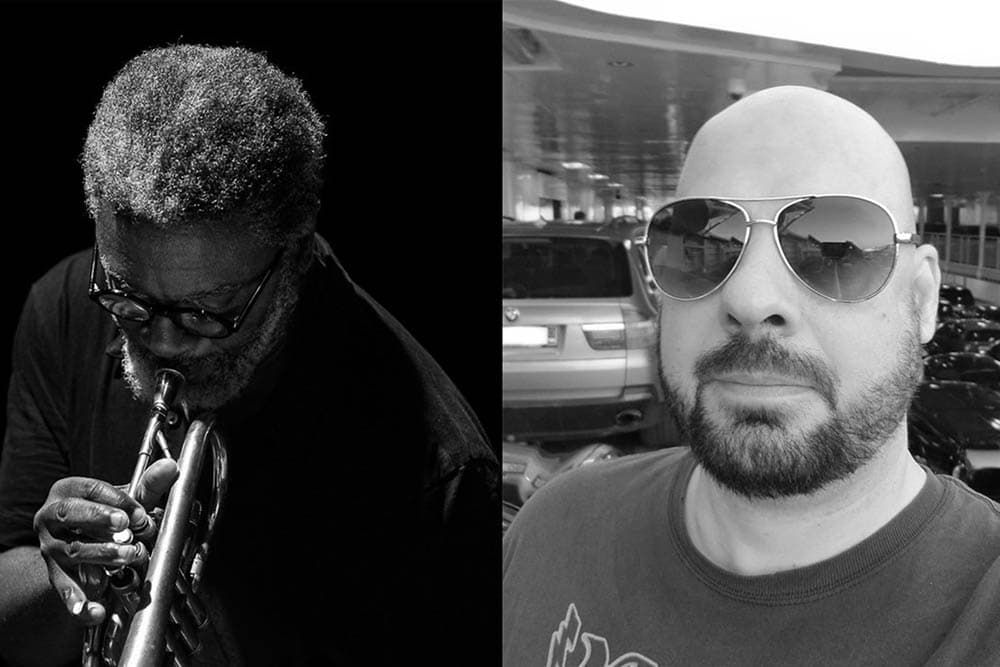
Combining jazz and electronic music can sometimes be a hit-or-miss affair. Often it seems musicians were shoved together in ill-fitting combinations in order to produce what felt like novelty records. If the participants did appreciate both styles of music, they nevertheless failed to assimilate the language of the other genre. This is no longer the case as enough time has elapsed for true cross-fertilization to take place. The new album Echolocation featuring cornet by Graham Haynes and electronics by Submerged (aka Kurt Glück-Aeg) proves that musicians from these two worlds can come together and produce fascinating results.
The recordings for Echolocation took place last winter with Haynes doing his portion first in Brazil and then Submerged doing his part in Estonia. Knowing the process indicates that this probably isn’t Jazz in the conventional sense. The give and take between the musicians don’t take place in real-time, yet one may be forgiven for thinking otherwise.
On tracks such as album opener “Siler City” or “Moscow”, Haynes seems to play in direct response to the drums, constructing a funk ostinato on the former while picking up speed to match the crazed drum breaks of the latter. It’s hard to understand how the horn came first in the music’s construction. Perhaps the question of “how” is just for the musicians, let the listeners enjoy the results. It is important to remember that post-production has played an important role in Jazz since Miles Davis’ 1970 Bitches Brew, an album that could certainly be seen as a distant ancestor of Echolocation.
Throughout much of the record, Haynes tends to take a minimalist approach. His playing is never busy but instead interjects small melodic fragments over the top of the beats. These are often run through a varying level of effects, which helps his tone sit more comfortably alongside the electronic elements. On “Istanbul Grand Prix”, he enters the tune with barely a wisp, his tone blending with the various samples that accompany the floor-rattling drums. Through much of the song, the cornet possesses a spectral presence, pushed to the back of the mix and coated in a distant reverb.
“Bushwick” finds his cornet sampled and turned into a repeating figure that establishes the tune’s identity at the beginning. When this part drops away, he layers more phrases one on top of another creating an ambient wash. His whole approach also seems to summon the ghost of 1969’s In a Silent Way, another of Miles Davis’ records that seems to point the way for this music.
Nevertheless, Echolocation doesn’t really feel like a Jazz record. Instead, the closest antecedent seems to be the short-lived illbient scene that flourished in the ’90s. Artists such as DJ Olive and DJ Spooky fused hip-hop, drum and bass, and ambient music into an alien conglomeration of beats and moods that proved intoxicating. While that scene found its epicenter in Brooklyn, artists from around the world joined in.
More specifically, the music on Echolocation seems to nod towards 1995’s Re-Entry by the British act Techno-Animal. On that record, the duo of Justin Broadrick, best known as the leader of Godflesh, and Kevin Martin (who would later be known as the Bug) were joined by the late Jon Hassell on trumpet. Hassell, like Haynes on this record, employed a variety of effects to expand the possibilities of his instrument and fit in more with the surrounding electronica. Both construct an intriguing siren song over the top of the heavyweight beats, although Submerged and Haynes utilize a wider rhythmic palette in constructing Echolocation.
This is not the first time these musicians have appeared together, both having participated in Bill Laswell’s Methods of Defiance project, but the collaboration present here provides a more focused vision that benefits the music immensely. Where the aforementioned records find various musicians interjecting themselves into the skeletons of songs, Echolocation is a well-thought-out collaboration between two veteran artists.
While Re-Entry moved with a relentless dub momentum, Echolocation is a much more nimble record that still paints a nocturnal picture. Its marriage of drum and bass and jazz moves the listener from the cyberpunk visions of electronica and the groundbreaking work of Miles Davis on Bitches Brew. It is notable that while both seemed to be forward-looking in their conception, they are now products of the past. Echolocation, though, feels perfectly in the moment and provides a fascinating listening experience regardless of where it lands in the continuum of music history.


![Call for Papers: All Things Reconsidered [MUSIC] May-August 2024](https://www.popmatters.com/wp-content/uploads/2024/04/all-things-reconsidered-call-music-may-2024-720x380.jpg)



